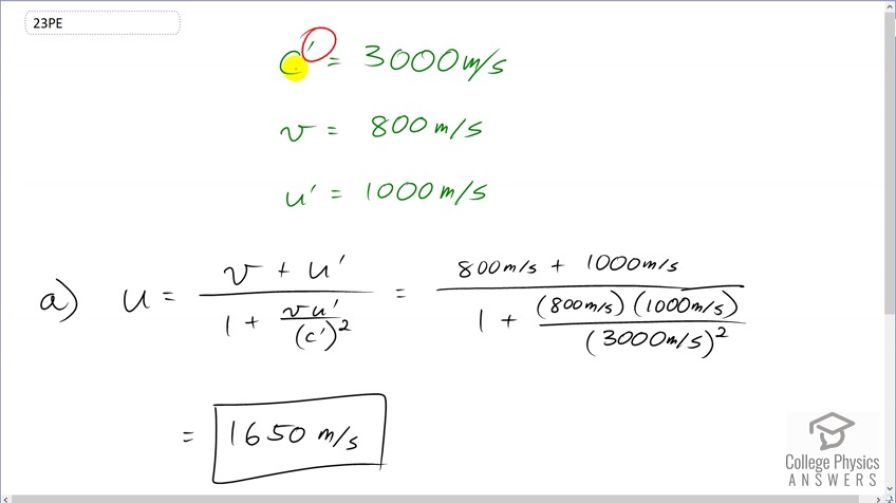Question
(a) Suppose the speed of light were only 3000 m/s . A jet fighter moving toward a target on the ground at 800 m/s shoots bullets, each having a muzzle velocity of 1000 m/s. What are the bullets’ velocity relative to the target? (b) If the speed of light was this small, would you observe relativistic effects in everyday life? Discuss.
Final Answer
- Yes, relativistic effects would commonly be observed if
Solution video
OpenStax College Physics, Chapter 28, Problem 23 (Problems & Exercises)

vote with a rating of
votes with an average rating of
.
Calculator Screenshots
Video Transcript
This is College Physics Answers with Shaun Dychko. In this question, we assume that the speed of light is only 3000 meters per second so I put a prime on the c here to label this as the speed of light that's just for this particular question, not the real c that we are used to— 3 times 10 to the 8 meters per second. In this case, c prime is 3000. Now a fighter jet is moving with a velocity of 800 meters per second towards this target and it shoots some bullets and the bullets have a muzzle velocity of 1000 meters per second. So the bullet velocity is being measured by the pilot in the fighter jet. And so that's why this gets labeled with the speed or velocity, u prime because it's being measured by the observer that's in the moving reference frame. And so the target we assume is stationary; this velocity v is the velocity with which the reference frame of the pilot is moving towards the target and then this velocity, u prime, is in turn being measured by the moving pilot. OK. So the question is, what is u? What velocity does the a person, who is the target, gonna be measuring for these bullets? It's gonna be the velocity of the fighter jet plus the muzzle velocity measured by the pilot. So 800 plus a 1000 and divide it by 1 plus 800 times a 1000 divided by the speed of light 3000 meters per second squared. And this gives a velocity of 1650 meters per second. So this is a significant relativistic effect here when the speed of light is so low because the classical result would say that the bullets will approach the target with a velocity of 1800 meters per second; Galilean relativity or classical relativity says just add the velocity of the reference frame plus the velocity reported by an observer in the moving reference frame but in relativity, it has to be added this way. And so the answer to part (b) is yes; relativistic effects would commonly be observed if the speed of light were only 3000 meters per second.
